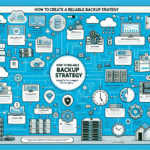Performing disaster recovery (DR) drills for backups is essential to ensure your organization is prepared to recover data and systems in the event of an actual disaster. As an IT manager responsible for the infrastructure, follow these steps to conduct effective DR drills:
1. Plan the Disaster Recovery Drill
- Define Objectives: Determine what you want to achieve with the drill (e.g., testing specific backup systems, recovery time objectives (RTO), recovery point objectives (RPO), or identifying gaps in the process).
- Scope: Decide which systems, applications, and data sets will be tested.
- Document the Plan: Create a detailed DR drill plan, including step-by-step procedures, roles, and responsibilities of team members.
2. Notify Stakeholders
- Inform relevant stakeholders (IT teams, department heads, application owners, etc.) about the upcoming DR drill.
- Clarify whether this will involve production systems or a test environment.
- Ensure leadership understands the purpose and potential impacts of the drill.
3. Create a Test Environment
- Sandbox Environment: Set up a separate environment to test recovery without impacting production systems.
- Simulate a Disaster: Choose a scenario (e.g., ransomware attack, hardware failure, accidental data deletion) to mimic a real-world disaster.
- Backup Data: Ensure you have copies of the latest backup data available for testing.
4. Execute the Recovery Process
- Restore Data: Perform a recovery from the backup system, restoring data to the test environment.
- Validate Integrity: Check the restored data for completeness and consistency.
- Test Applications: Verify that restored applications and systems are functional and can perform as intended.
- Measure Time: Record the time taken to recover, comparing it to your defined RTO and RPO.
5. Document Observations
- Log any issues encountered during the recovery process, such as missing data, corrupted files, or delays.
- Note what worked well and what could be improved.
6. Evaluate Backup Systems
- Storage Type: Ensure backups are stored securely and are accessible during recovery (e.g., disk-based, cloud-based, tape storage).
- Frequency: Confirm backup schedules meet organizational needs (e.g., daily incremental backups or weekly full backups).
- Redundancy: Ensure backups are replicated across multiple locations for added resilience.
7. Provide Feedback to Teams
- Share the results of the drill with your team and stakeholders.
- Highlight successes and areas needing improvement.
8. Address Identified Issues
- Resolve any technical or procedural gaps discovered during the drill.
- Update backup and DR policies as needed.
9. Repeat Regularly
- Schedule DR drills periodically (e.g., quarterly or annually) to ensure preparedness.
- Test different scenarios each time to cover a range of potential disasters.
10. Incorporate Automation
- Use backup and recovery tools with automation features to streamline the process.
- Test automated scripts and workflows during drills to ensure they function as expected.
11. Ensure Compliance
- Verify that your DR drill aligns with organizational policies and regulatory requirements (e.g., GDPR, HIPAA, SOC 2).
12. Test Specific Scenarios
- Ransomware Recovery: Test recovering from immutable backups or air-gapped storage.
- Cloud Recovery: Test recovering data stored in the cloud.
- Virtualized Environment: Simulate recovery for virtual machines (e.g., VMware, Hyper-V).
- Kubernetes: Test restoring workloads and persistent volumes within Kubernetes clusters.
13. Leverage Reporting
- Generate detailed reports from backup software or tools to analyze recovery performance.
- Use these reports to justify improvements in backup infrastructure or increased investment in DR solutions.
Tools & Technologies to Consider
- Backup Solutions: Veeam, Commvault, Cohesity, Rubrik, Acronis.
- Cloud Backup: AWS Backup, Azure Backup, Google Cloud Backup.
- Virtualization: VMware vSphere Data Protection (VDP), Veeam for VMware/Hyper-V.
- Kubernetes Backup: Velero, Kasten K10.
- Immutable Storage: Use write-once-read-many (WORM) storage for ransomware resilience.
A well-executed DR drill will ensure your team is confident in handling a disaster and that your backup systems are reliable and capable of meeting your business continuity requirements.
How do I perform disaster recovery drills for backups?



